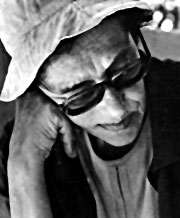
She was born in Wuppertal-Elberfeld, Germany, in 1904. Between 1923 and 1925 she studied graphic arts in the Kunstgewerbeschule, Stuttgart. Then she studied photography with Walter Peterhans and installed a graphic design and photography studio in Berlin, with her friend Ellen Auerbach, which they named ringl+pit. In 1932 she attended the Bauhaus photography workshop in Dessau during two semesters due to the institution closing when Adolf Hitler assumed power. In that political context, she decided to emigrate to England.
In 1935 she married an Argentine photographer, Horacio Coppola, and travelled to Buenos Aires for the first time, where both of them had an exhibition in the offices of Sur magazine. Her daughter Silvia was born the following year, and the family settled in Argentina.
Grete Stern began to portray intellectuals and artists, and in 1940 –when her son Andrés was born– she began to work for important printing presses and advertising agencies.
In 1943 she made her first individual exhibition at the Müller Gallery and divorced Coppola. In 1945 the concrete artists organized the Movimiento de Arte-Invención exhibition, at her house in Ramos Mejía. During this period she photographed the Monument to Sarmiento, by Auguste Rodin, the series Patios of Buenos Aires —which she continued until mid-60s—, and performed photocompositions for Idilio magazine.
In 1956, Jorge Romero Brest summoned her to organize and direct the photography workshop of the Museo Nacional de Bellas Artes, a position she held until 1970.
In 1958 she adopted the Argentine nationality and, the following year, taught photography at the School of Humanistic of the National University of the Northeast, Chaco, while documenting regional subjects and the Jesuitical ruins in Misiones. She travelled through almost all the Argentine provinces, making photographic series.
In 1964 she was awarded a National Arts Fund scholarship to work on the habits and habitat of the aboriginals in the Great Chaco.
In 1972 she travelled to the United States, England, Germany, Greece, Israel, and France, where she portrayed plastic artists and Parisian writers. In Germany she had her first photographs exhibited after the war, at the Bauhaus-Archiv, Berlin, in 1975, and in 1978, she participated in Experimental Photography in Germany, from 1918 to 1940, at the Gallery of Levante, Munich, which initiated the recovery of the memory of pre-Fascist photography.
In 1985 she decided to abandon her work in photography, and gave away her equipment to her students and collaborators. Among her more outstanding individual exhibitions, Grete Stern, Photographies 1927-1980, at the Fundación San Telmo, Buenos Aires (1981) deserves to be mentioned, as well as Grete Stern, Museo Nacional de Bellas Artes, Buenos Aires (1988); Grete Stern, Portraits 1930-1950, Galerie Viviane Esders, Paris (1989); Dreams, Grete Stern, Instituto Valenciano de Arte Moderno, Valencia (1995); Grete Stern, Photographic work in Argentina, hosted by the Goethe Institut in Argentina, Brazil, Venezuela, Germany, Colombia, and Ecuador (1997/8); and Grete Stern, The dreams, Staatliche Galerie Moritzburg, Halle, and Suermondt Ludwig Museum, Aachen (1999).
After a ceaseless photographic work in Argentina, she died in Buenos Aires, on December 24, 1999, at 95 years of age.